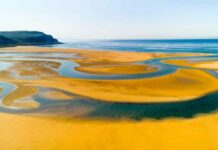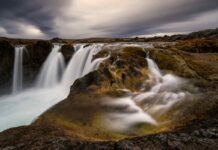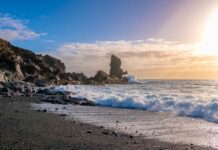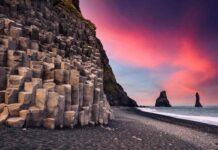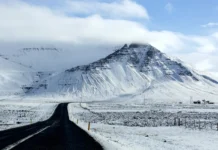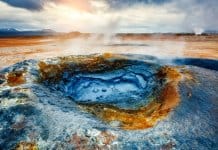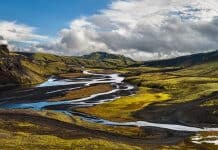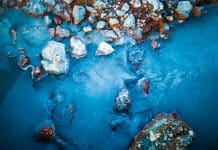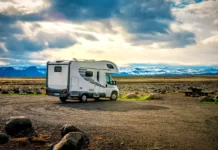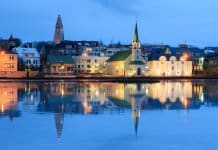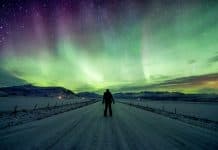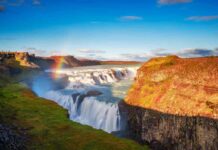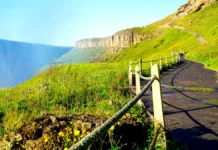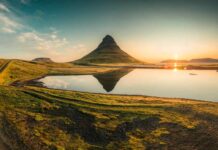Visiting Iceland in July offers a unique and unforgettable experience. With its stunning landscapes, vibrant culture, and endless daylight, July is an ideal time to explore this incredible destination. This guide covers everything you need to know about Iceland in July, including weather, activities, and essential tips for travelers.
Iceland Weather in July
Weather in Iceland in July is generally mild and pleasant, making it one of the best months to visit. The average temperature ranges from 10°C (50°F) to 15°C (59°F). However, it can occasionally reach as high as 20°C (68°F). This comfortable temperature range allows for a variety of outdoor activities, from hiking to sightseeing, without the extremes of heat or cold.
Daylight and Sunlight
One of the most remarkable features of July in Iceland is the long daylight hours. Known as the Midnight Sun, this phenomenon results in up to 21 hours of daylight. The sun sets around midnight and rises again around 3 AM, providing ample opportunity to explore the stunning landscapes of Iceland almost around the clock. This extended daylight is perfect for those who want to maximize their time outdoors and see as much as possible during their visit.

Precipitation
How much does it rain in Iceland in July? Despite being one of the driest months, July in Iceland still experiences some rainfall. On average, there are about 15-20 days of precipitation. However, the rain is typically light and in the form of showers, which means it often doesn’t interfere much with outdoor activities.
Wind and Weather Variability
While July is one of the most favorable months in terms of weather, it’s important to note that Icelandic weather can be highly variable. The island’s position in the North Atlantic means it is frequently subject to sudden changes in weather. It’s not uncommon to experience sunshine, rain, and wind all within the same day. Therefore, it’s crucial to be prepared for all types of weather conditions.
Things to Do in Iceland in July
Explore Reykjavik in July
Reykjavik in July is bustling with activities and events. The city’s vibrant nightlife, cultural festivals, and outdoor concerts provide endless entertainment. Here are some top things to do in Reykjavik in July:
- Attend the Reykjavik Arts Festival: This annual event showcases local and international artists, featuring exhibitions, performances, and workshops.
- Visit the Harpa Concert Hall: This iconic building hosts various concerts and events, offering a blend of contemporary and classical music.
- Explore the Old Harbour: Enjoy whale watching tours, seafood restaurants, and charming shops along the waterfront.

Natural Wonders and Outdoor Activities
What to do in Iceland in July extends beyond the capital city. The country’s natural beauty is at its peak, offering numerous outdoor adventures. Here are some of the top activities to immerse yourself in Iceland’s stunning landscapes and unique natural phenomena:
Golden Circle Tour
The Golden Circle Tour is a must-do when visiting Iceland. This popular route includes three of Iceland’s most famous natural attractions:
- Gullfoss Waterfall: Known as the “Golden Falls,” Gullfoss is a spectacular waterfall where the Hvítá River plunges into a crevice with immense power. The double cascade creates an awe-inspiring view, especially when the sun creates rainbows in the mist.
- Geysir Geothermal Area: Home to the famous Strokkur geyser, which erupts every 5-10 minutes, shooting boiling water up to 30 meters (98 feet) into the air. This geothermal field is rich with hot springs, bubbling mud pots, and steaming fumaroles.
- Thingvellir National Park: A UNESCO World Heritage site, Thingvellir is not only significant for its geological features but also for its historical importance as the site of the world’s first parliament, the Althing, established in 930 AD. The park lies in a rift valley, where the Eurasian and North American tectonic plates are slowly pulling apart, creating dramatic landscapes.

Hiking in Iceland in July
Hiking in Iceland in July is an unforgettable experience, with numerous trails offering a variety of landscapes and challenges:
- Landmannalaugar: Known for its colorful rhyolite mountains, Landmannalaugar is a hiker’s paradise. The area features hot springs, lava fields, and vibrant peaks. The Laugavegur Trail, one of the most famous multi-day hikes, starts here and takes you through diverse terrains to Thorsmork.
- Fimmvörðuháls: This challenging trail takes you between two glaciers, Eyjafjallajökull and Mýrdalsjökull. Along the way, you’ll encounter waterfalls, volcanic landscapes, and stunning views. The hike ends in the beautiful Thorsmork valley, known for its lush greenery and dramatic scenery.

Whale Watching
Whale Watching in Iceland in July offers a unique opportunity to see some of the ocean’s most magnificent creatures:
- Prime Viewing Time: July is an excellent time for whale watching due to the favorable weather and abundance of marine life. The waters around Iceland are rich in krill and fish, attracting a variety of whale species.
- Species: You can expect to see humpback whales, minke whales, and orcas. The humpback whales, known for their acrobatic breaches and long pectoral fins, are particularly popular among visitors.
- Locations: Whale watching tours depart from several locations around Iceland, including Reykjavik, Husavik, and Akureyri. Husavik, known as the whale-watching capital of Iceland, offers some of the best opportunities to see these majestic animals up close.

Additional Outdoor Activities
Beyond the well-known tours and trails, Iceland offers a plethora of outdoor activities to suit all interests:
- Glacier Exploration: Take guided tours to explore Iceland’s massive glaciers, such as Vatnajökull and Langjökull. Activities include glacier hiking, ice climbing, and even visiting ice caves.
- Puffin Watching: July is also a great time to see puffins, especially in places like the Westman Islands and Dyrhólaey. These charming birds nest in large colonies along the cliffs, providing excellent photo opportunities.
- Horseback Riding: Experience the unique Icelandic horse, known for its smooth gait called the tölt. Riding tours take you through beautiful landscapes, including lava fields, beaches, and meadows.

Packing for Outdoor Adventures
Given the variability of Iceland’s weather, it’s crucial to pack appropriately for outdoor activities:
- Layered clothing: As with any Iceland trip, layers are essential. Base layers, insulating mid-layers, and waterproof outer layers will keep you comfortable.
- Sturdy footwear: Good quality hiking boots with ankle support and waterproof features are a must for the rugged terrain.
- Sun protection: Despite the cooler temperatures, the sun can be quite strong, especially with the extended daylight. Pack sunscreen, sunglasses, and a hat.
Unique Icelandic Experiences
- Midnight Sun Golf: Play golf under the midnight sun at one of Iceland’s scenic courses.
- Visit Puffin Colonies: The Westman Islands and Látrabjarg cliffs are home to large puffin populations during this time of year.
- Relax in Hot Springs: Soak in the soothing waters of the Blue Lagoon or the lesser-known Mývatn Nature Baths.

Frequently Asked Questions
Is July a good time to travel to Iceland?
Yes, July is a good time to visit Iceland. The weather is mild, and the long daylight hours allow you to make the most of your trip. It’s also the peak season for festivals and outdoor activities.
Can I see the Northern Lights in Iceland in july?
Unfortunately, you cannot see the Northern Lights in Iceland in July. The long daylight hours make it impossible to view this natural phenomenon. The best time to see the Northern Lights is from late September to early April.
Is Iceland expensive in July?
Iceland can be expensive in July, as it is the peak tourist season. Prices for accommodations, tours, and flights are generally higher. However, planning and booking in advance can help manage costs.
Is it worth going to Iceland in summer?
Absolutely. Visiting Iceland in summer allows you to experience the country’s natural beauty in full bloom. The pleasant weather and long days provide ample opportunities for outdoor activities and exploration.
Tips for Visiting Iceland in July
Packing Essentials
- Layers: The weather can change quickly, so bring layers to stay comfortable.
- Waterproof Clothing: Essential for dealing with rain and wind.
- Sturdy Footwear: Necessary for hiking and exploring rough terrain.
Transportation
Renting a car is a popular option for exploring Iceland at your own pace. Campervans are also a great choice, offering flexibility and convenience. Check out our comprehensive comparison of campervan rentals in Iceland for more details.
Fuel Prices
Fuel prices in Iceland can be high, with average prices around 240-260 ISK per liter (approximately $1.80-$2.00 USD). Planning your routes and budgeting for fuel costs is essential.
Iceland in July is a magical destination that offers a perfect blend of natural beauty, cultural experiences, and outdoor adventures. Whether you’re exploring the bustling streets of Reykjavik, hiking through stunning landscapes, or relaxing in hot springs, July is an excellent time to visit this incredible country. Plan your trip, pack wisely, and get ready for an unforgettable Icelandic summer.
For those interested in exploring Iceland with the convenience of a mobile home, don’t forget to check out our comprehensive comparison of campervan rentals in Iceland.
This comprehensive guide covers everything you need to know about visiting Iceland in July, ensuring you have all the information to make the most of your summer adventure. Enjoy your trip!

